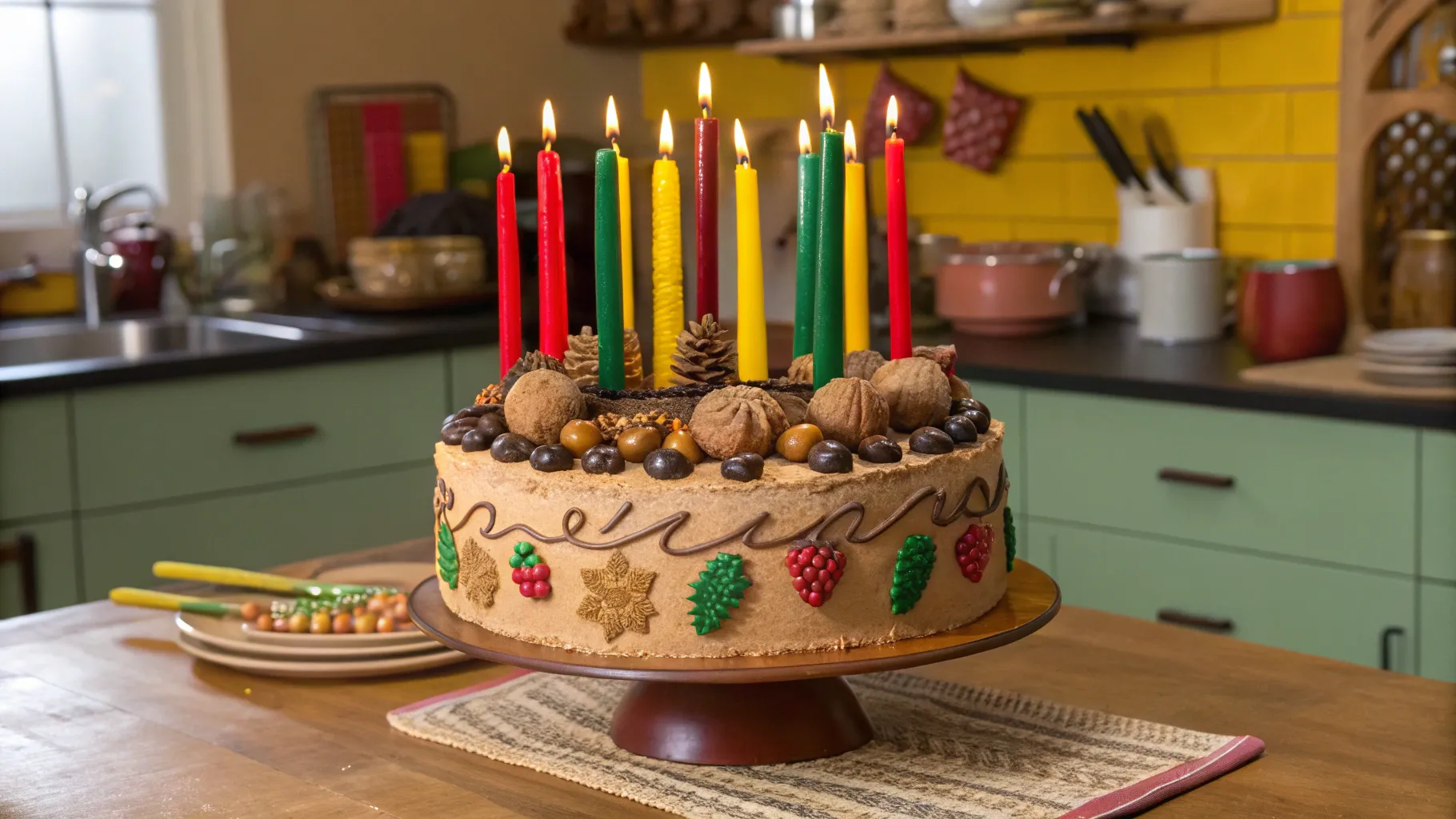
When it comes to cooking, easy recipes can sometimes take a surprising turn. One such example is the infamous Kwanzaa cake created by Sandra Lee, a recipe that has sparked curiosity, confusion, and a fair share of internet debates. This cake, which made waves online for all the wrong reasons, is now getting a second look. Let’s explore what makes this cake so memorable, and see if it’s worth trying out in your kitchen.
A Cake That Raises Eyebrows
The internet is filled with all kinds of recipes—some delicious, others downright questionable. The Kwanzaa cake by Sandra Lee falls firmly into the latter category, earning a notorious reputation. On the surface, it looks like an art project more than a dessert, topped with unusual ingredients like popcorn, corn nuts (mistakenly called acorns), and pumpkin seeds. But what exactly is a Kwanzaa cake, and how did this peculiar creation come to be?
This cake’s base is a store-bought angel food cake, which is light and delicate, usually paired with airy frostings or fruit toppings. Instead, Sandra Lee’s version uses a dense American buttercream frosting mixed with cinnamon and cocoa powder, creating a flavor profile that doesn’t quite connect to traditional Kwanzaa or African diaspora desserts.

Adding canned apple pie filling into the center of the cake adds another layer of confusion. While fruit fillings are common in cakes, canned pie filling is rarely used in traditional celebrations. The topping of popcorn, pumpkin seeds, and corn nuts takes the cake into unexpected territory, making many question the recipe’s authenticity and purpose.
What’s the Story Behind Kwanzaa Cake?
Many people have never heard of a Kwanzaa cake before, and with good reason—such a specific dessert doesn’t traditionally exist. Kwanzaa celebrations typically feature dishes rooted in African, Caribbean, and Southern soul food traditions, like sweet potato pie, rum cake, or coconut-flavored desserts. The angel food cake with popcorn and corn nuts does not fit into these categories.
Even the candles on the cake, which are meant to represent the Pan African flag colors, seem oddly sized and misplaced, appearing more like decorations borrowed from a fireplace mantle than a cake topper. This disconnected approach has led many to believe the recipe was created without proper cultural research or understanding.

Recreating the Chaos: A Chef’s Take
A professional chef decided to recreate this infamous cake to see if it could redeem itself. Starting with a store-bought angel food cake, the chef cut it in half and prepared a homemade buttercream frosting spiced with cinnamon and cocoa powder to match the original recipe’s flavor profile. While angel food cake usually pairs well with light frostings like whipped cream or fruit sauces, the heavier buttercream was used to stay true to the recipe.

The cake layers were assembled upside down for a smooth finish, and multiple types of frosting were used to cover the cake completely, despite the original recipe claiming to use only one. Then came the filling—a hole in the center of the cake was stuffed with canned apple pie filling, adding a sweet, fruity surprise that felt out of place.
The finishing touches included popcorn, pumpkin seeds, and corn nuts, the latter controversially referred to as acorns, which are not edible and definitely not a typical cake ingredient. The chef followed the instructions faithfully, honoring the chaotic spirit of the original recipe.

The Taste Test: Surprising Reactions
Despite the odd combination of ingredients, the chef’s guest was pleasantly surprised by the cake. The angel food cake’s light texture combined with the chocolate cinnamon frosting created a unique flavor, while the popcorn and seeds added interesting crunch and texture. The guest appreciated the Kwanzaa colors and even gave the cake a glowing five-star rating, admitting a desire for leftovers.
However, this positive reception contrasts sharply with the harsh criticisms found in online comments, where many users dismissed the cake as a cultural misstep or even offensive. Some commenters pointed out the cake’s lack of connection to authentic Kwanzaa traditions, while others were baffled by the popcorn topping and the puzzling choice of ingredients.

What Can We Learn from This?
The Kwanzaa cake phenomenon highlights the importance of cultural respect and authenticity in cooking, especially when representing traditions. It also reminds us that cooking, easy recipes sometimes take unexpected paths, and not every recipe will resonate with everyone.
While this cake might not be a staple for holiday celebrations, it’s a fun and quirky example of how recipes can spark conversation and curiosity. Whether you’re an adventurous cook or someone who prefers sticking to classic recipes, this cake serves as a reminder to explore, question, and enjoy the process of cooking.
So, if you’re looking to try something different and don’t mind a little kitchen chaos, the Kwanzaa cake might just be the recipe to surprise you. Just remember to keep an open mind and a sense of humor when diving into the world of cooking, easy recipes!
This article was created from the video The Kwanzaa Cake That Broke The Internet... Let’s Make It with the help of AI.
The Kwanzaa Cake That Broke The Internet: A Fun Dive into Cooking and Easy Recipes. There are any The Kwanzaa Cake That Broke The Internet: A Fun Dive into Cooking and Easy Recipes in here.
